University Reflective Journal on Intercultural Communication Insights
VerifiedAdded on 2022/12/18
|11
|2866
|1
Journal and Reflective Writing
AI Summary
This reflective journal documents a student's learning journey in intercultural communication over six weeks, covering essential topics such as cultural values, culture shock, language, and communication patterns. The journal explores the impact of cultural imperatives, including technological and demographic influences, on organizational diversity and the importance of ethics. It highlights communication barriers, cultural differences in norms and values, and the challenges faced in intercultural interactions. The author reflects on the impact of cultural values in international business, gender equality, and the importance of respecting diverse cultural perspectives. The journal further examines cultural shock, language barriers, and the role of both verbal and non-verbal communication in fostering effective cross-cultural understanding. It provides insights into the differences in communication styles, such as those between American and Japanese cultures, emphasizing the significance of adapting to different cultural norms to avoid misunderstandings. The author concludes by emphasizing the importance of learning English, the universal language, and the need to respect cultural differences to improve global communication.
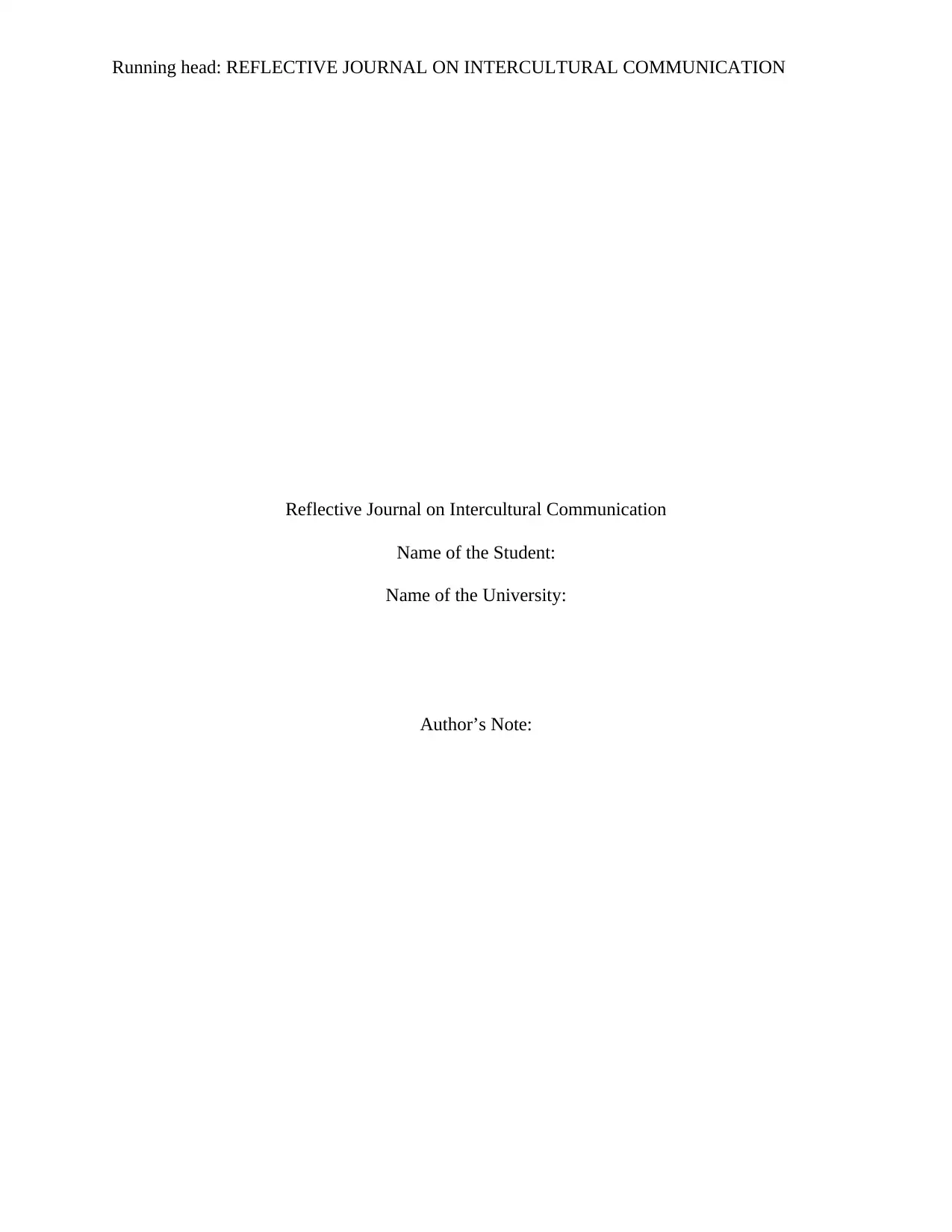
Running head: REFLECTIVE JOURNAL ON INTERCULTURAL COMMUNICATION
Reflective Journal on Intercultural Communication
Name of the Student:
Name of the University:
Author’s Note:
Reflective Journal on Intercultural Communication
Name of the Student:
Name of the University:
Author’s Note:
Paraphrase This Document
Need a fresh take? Get an instant paraphrase of this document with our AI Paraphraser
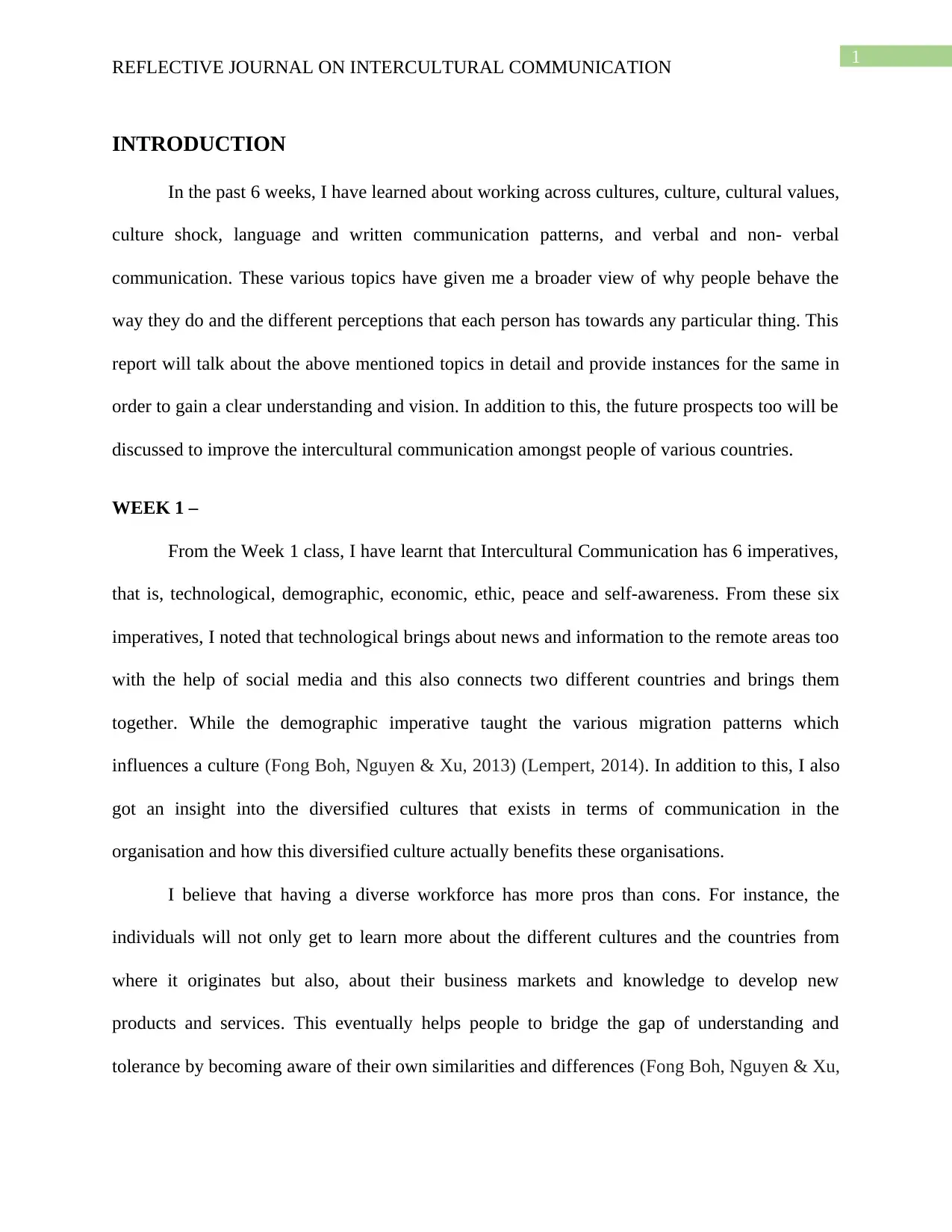
1
REFLECTIVE JOURNAL ON INTERCULTURAL COMMUNICATION
INTRODUCTION
In the past 6 weeks, I have learned about working across cultures, culture, cultural values,
culture shock, language and written communication patterns, and verbal and non- verbal
communication. These various topics have given me a broader view of why people behave the
way they do and the different perceptions that each person has towards any particular thing. This
report will talk about the above mentioned topics in detail and provide instances for the same in
order to gain a clear understanding and vision. In addition to this, the future prospects too will be
discussed to improve the intercultural communication amongst people of various countries.
WEEK 1 –
From the Week 1 class, I have learnt that Intercultural Communication has 6 imperatives,
that is, technological, demographic, economic, ethic, peace and self-awareness. From these six
imperatives, I noted that technological brings about news and information to the remote areas too
with the help of social media and this also connects two different countries and brings them
together. While the demographic imperative taught the various migration patterns which
influences a culture (Fong Boh, Nguyen & Xu, 2013) (Lempert, 2014). In addition to this, I also
got an insight into the diversified cultures that exists in terms of communication in the
organisation and how this diversified culture actually benefits these organisations.
I believe that having a diverse workforce has more pros than cons. For instance, the
individuals will not only get to learn more about the different cultures and the countries from
where it originates but also, about their business markets and knowledge to develop new
products and services. This eventually helps people to bridge the gap of understanding and
tolerance by becoming aware of their own similarities and differences (Fong Boh, Nguyen & Xu,
REFLECTIVE JOURNAL ON INTERCULTURAL COMMUNICATION
INTRODUCTION
In the past 6 weeks, I have learned about working across cultures, culture, cultural values,
culture shock, language and written communication patterns, and verbal and non- verbal
communication. These various topics have given me a broader view of why people behave the
way they do and the different perceptions that each person has towards any particular thing. This
report will talk about the above mentioned topics in detail and provide instances for the same in
order to gain a clear understanding and vision. In addition to this, the future prospects too will be
discussed to improve the intercultural communication amongst people of various countries.
WEEK 1 –
From the Week 1 class, I have learnt that Intercultural Communication has 6 imperatives,
that is, technological, demographic, economic, ethic, peace and self-awareness. From these six
imperatives, I noted that technological brings about news and information to the remote areas too
with the help of social media and this also connects two different countries and brings them
together. While the demographic imperative taught the various migration patterns which
influences a culture (Fong Boh, Nguyen & Xu, 2013) (Lempert, 2014). In addition to this, I also
got an insight into the diversified cultures that exists in terms of communication in the
organisation and how this diversified culture actually benefits these organisations.
I believe that having a diverse workforce has more pros than cons. For instance, the
individuals will not only get to learn more about the different cultures and the countries from
where it originates but also, about their business markets and knowledge to develop new
products and services. This eventually helps people to bridge the gap of understanding and
tolerance by becoming aware of their own similarities and differences (Fong Boh, Nguyen & Xu,
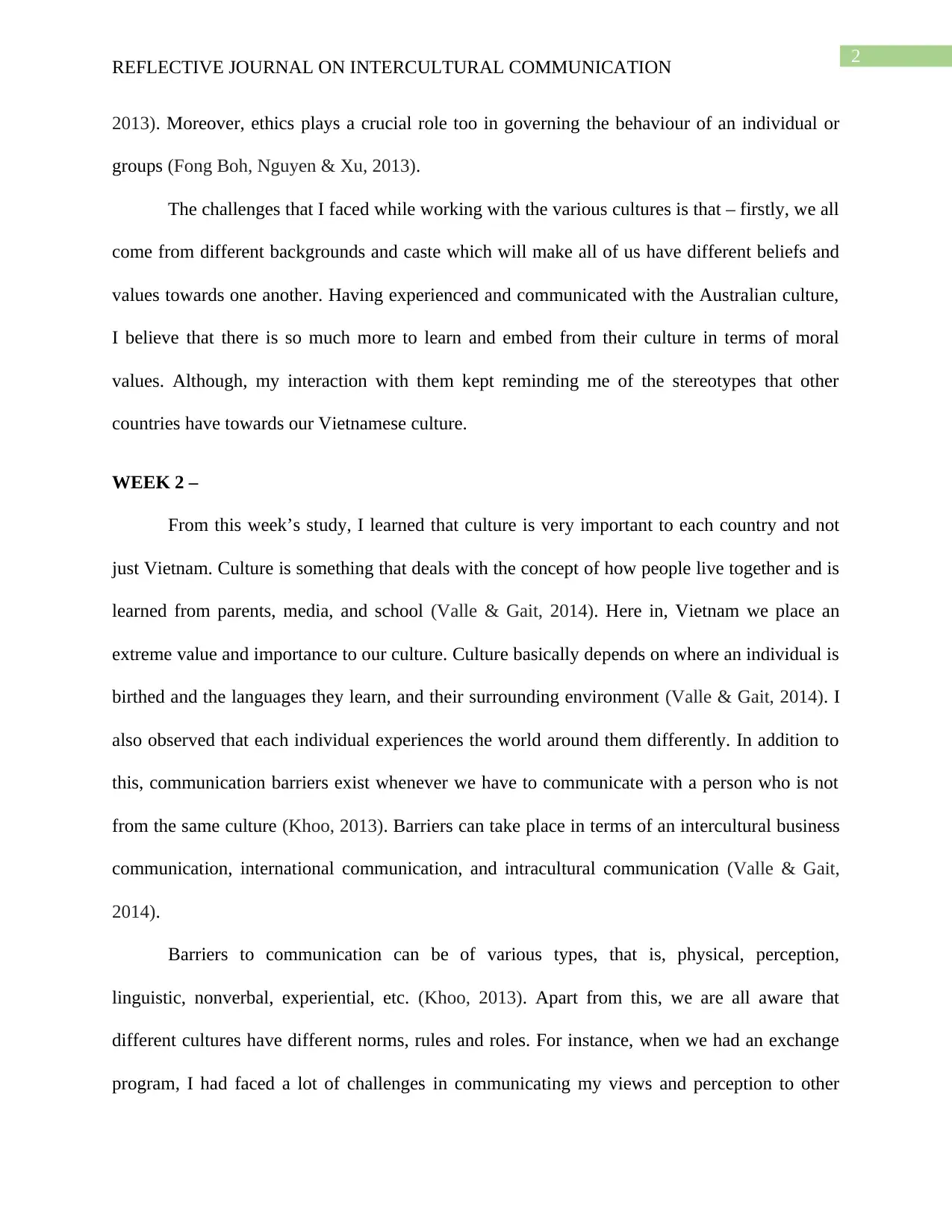
2
REFLECTIVE JOURNAL ON INTERCULTURAL COMMUNICATION
2013). Moreover, ethics plays a crucial role too in governing the behaviour of an individual or
groups (Fong Boh, Nguyen & Xu, 2013).
The challenges that I faced while working with the various cultures is that – firstly, we all
come from different backgrounds and caste which will make all of us have different beliefs and
values towards one another. Having experienced and communicated with the Australian culture,
I believe that there is so much more to learn and embed from their culture in terms of moral
values. Although, my interaction with them kept reminding me of the stereotypes that other
countries have towards our Vietnamese culture.
WEEK 2 –
From this week’s study, I learned that culture is very important to each country and not
just Vietnam. Culture is something that deals with the concept of how people live together and is
learned from parents, media, and school (Valle & Gait, 2014). Here in, Vietnam we place an
extreme value and importance to our culture. Culture basically depends on where an individual is
birthed and the languages they learn, and their surrounding environment (Valle & Gait, 2014). I
also observed that each individual experiences the world around them differently. In addition to
this, communication barriers exist whenever we have to communicate with a person who is not
from the same culture (Khoo, 2013). Barriers can take place in terms of an intercultural business
communication, international communication, and intracultural communication (Valle & Gait,
2014).
Barriers to communication can be of various types, that is, physical, perception,
linguistic, nonverbal, experiential, etc. (Khoo, 2013). Apart from this, we are all aware that
different cultures have different norms, rules and roles. For instance, when we had an exchange
program, I had faced a lot of challenges in communicating my views and perception to other
REFLECTIVE JOURNAL ON INTERCULTURAL COMMUNICATION
2013). Moreover, ethics plays a crucial role too in governing the behaviour of an individual or
groups (Fong Boh, Nguyen & Xu, 2013).
The challenges that I faced while working with the various cultures is that – firstly, we all
come from different backgrounds and caste which will make all of us have different beliefs and
values towards one another. Having experienced and communicated with the Australian culture,
I believe that there is so much more to learn and embed from their culture in terms of moral
values. Although, my interaction with them kept reminding me of the stereotypes that other
countries have towards our Vietnamese culture.
WEEK 2 –
From this week’s study, I learned that culture is very important to each country and not
just Vietnam. Culture is something that deals with the concept of how people live together and is
learned from parents, media, and school (Valle & Gait, 2014). Here in, Vietnam we place an
extreme value and importance to our culture. Culture basically depends on where an individual is
birthed and the languages they learn, and their surrounding environment (Valle & Gait, 2014). I
also observed that each individual experiences the world around them differently. In addition to
this, communication barriers exist whenever we have to communicate with a person who is not
from the same culture (Khoo, 2013). Barriers can take place in terms of an intercultural business
communication, international communication, and intracultural communication (Valle & Gait,
2014).
Barriers to communication can be of various types, that is, physical, perception,
linguistic, nonverbal, experiential, etc. (Khoo, 2013). Apart from this, we are all aware that
different cultures have different norms, rules and roles. For instance, when we had an exchange
program, I had faced a lot of challenges in communicating my views and perception to other
⊘ This is a preview!⊘
Do you want full access?
Subscribe today to unlock all pages.

Trusted by 1+ million students worldwide
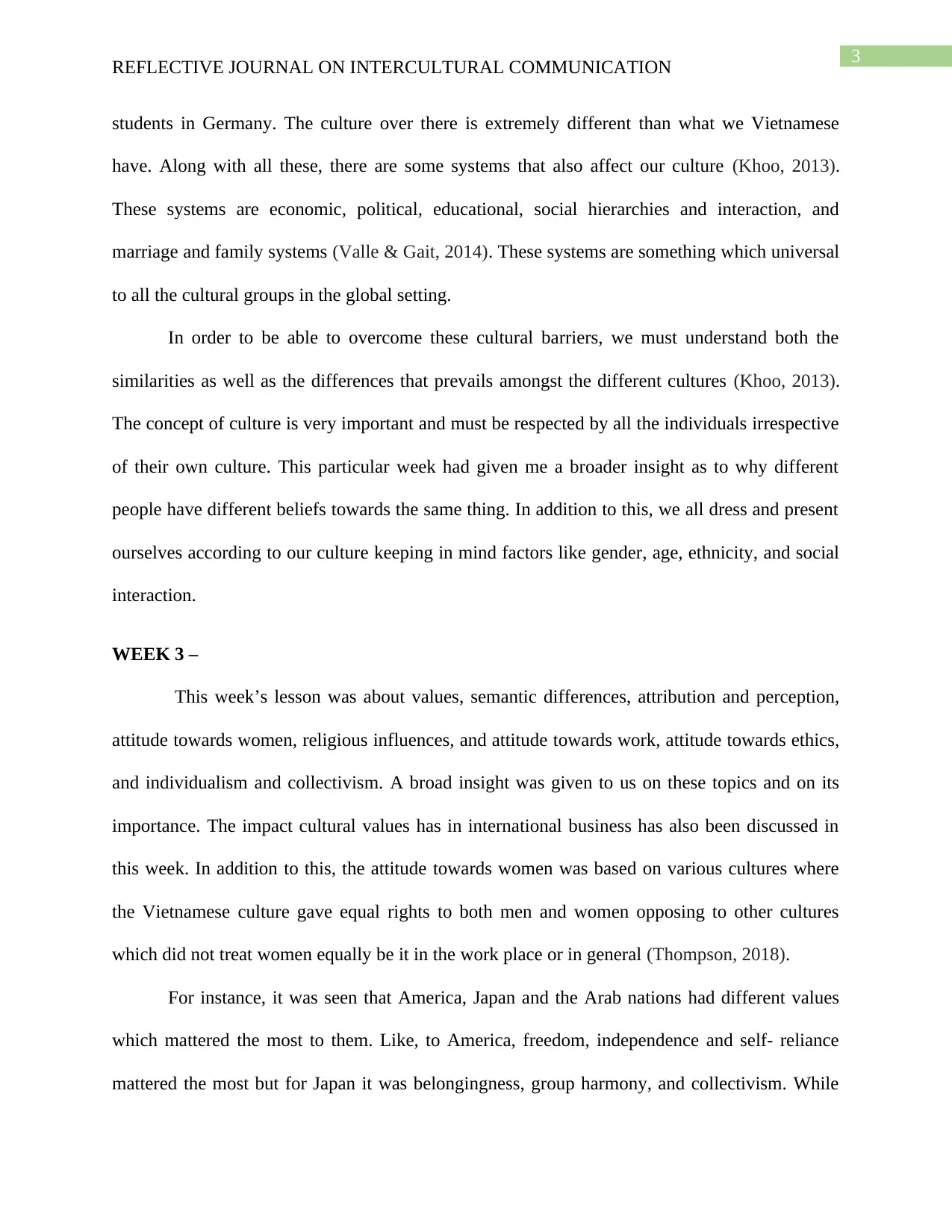
3
REFLECTIVE JOURNAL ON INTERCULTURAL COMMUNICATION
students in Germany. The culture over there is extremely different than what we Vietnamese
have. Along with all these, there are some systems that also affect our culture (Khoo, 2013).
These systems are economic, political, educational, social hierarchies and interaction, and
marriage and family systems (Valle & Gait, 2014). These systems are something which universal
to all the cultural groups in the global setting.
In order to be able to overcome these cultural barriers, we must understand both the
similarities as well as the differences that prevails amongst the different cultures (Khoo, 2013).
The concept of culture is very important and must be respected by all the individuals irrespective
of their own culture. This particular week had given me a broader insight as to why different
people have different beliefs towards the same thing. In addition to this, we all dress and present
ourselves according to our culture keeping in mind factors like gender, age, ethnicity, and social
interaction.
WEEK 3 –
This week’s lesson was about values, semantic differences, attribution and perception,
attitude towards women, religious influences, and attitude towards work, attitude towards ethics,
and individualism and collectivism. A broad insight was given to us on these topics and on its
importance. The impact cultural values has in international business has also been discussed in
this week. In addition to this, the attitude towards women was based on various cultures where
the Vietnamese culture gave equal rights to both men and women opposing to other cultures
which did not treat women equally be it in the work place or in general (Thompson, 2018).
For instance, it was seen that America, Japan and the Arab nations had different values
which mattered the most to them. Like, to America, freedom, independence and self- reliance
mattered the most but for Japan it was belongingness, group harmony, and collectivism. While
REFLECTIVE JOURNAL ON INTERCULTURAL COMMUNICATION
students in Germany. The culture over there is extremely different than what we Vietnamese
have. Along with all these, there are some systems that also affect our culture (Khoo, 2013).
These systems are economic, political, educational, social hierarchies and interaction, and
marriage and family systems (Valle & Gait, 2014). These systems are something which universal
to all the cultural groups in the global setting.
In order to be able to overcome these cultural barriers, we must understand both the
similarities as well as the differences that prevails amongst the different cultures (Khoo, 2013).
The concept of culture is very important and must be respected by all the individuals irrespective
of their own culture. This particular week had given me a broader insight as to why different
people have different beliefs towards the same thing. In addition to this, we all dress and present
ourselves according to our culture keeping in mind factors like gender, age, ethnicity, and social
interaction.
WEEK 3 –
This week’s lesson was about values, semantic differences, attribution and perception,
attitude towards women, religious influences, and attitude towards work, attitude towards ethics,
and individualism and collectivism. A broad insight was given to us on these topics and on its
importance. The impact cultural values has in international business has also been discussed in
this week. In addition to this, the attitude towards women was based on various cultures where
the Vietnamese culture gave equal rights to both men and women opposing to other cultures
which did not treat women equally be it in the work place or in general (Thompson, 2018).
For instance, it was seen that America, Japan and the Arab nations had different values
which mattered the most to them. Like, to America, freedom, independence and self- reliance
mattered the most but for Japan it was belongingness, group harmony, and collectivism. While
Paraphrase This Document
Need a fresh take? Get an instant paraphrase of this document with our AI Paraphraser
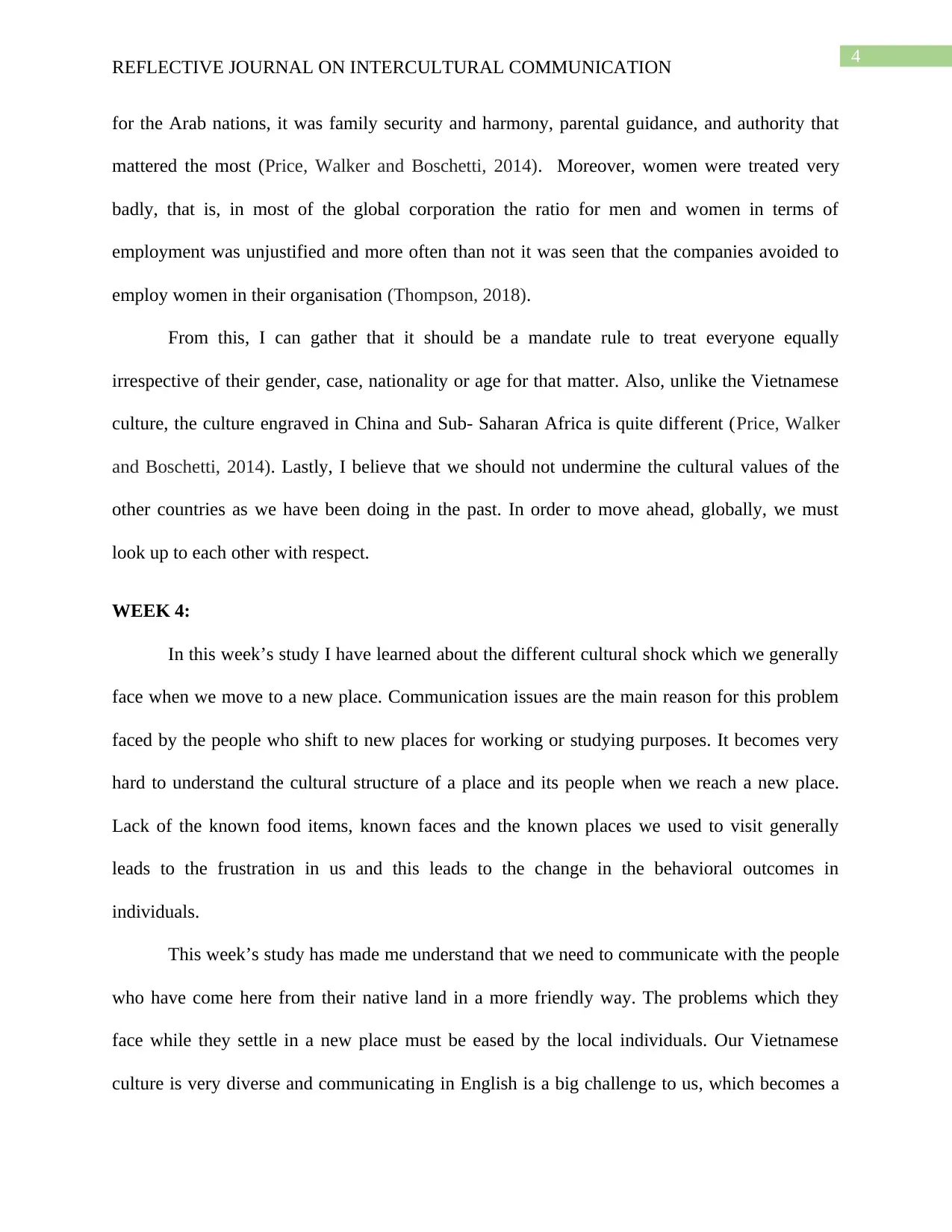
4
REFLECTIVE JOURNAL ON INTERCULTURAL COMMUNICATION
for the Arab nations, it was family security and harmony, parental guidance, and authority that
mattered the most (Price, Walker and Boschetti, 2014). Moreover, women were treated very
badly, that is, in most of the global corporation the ratio for men and women in terms of
employment was unjustified and more often than not it was seen that the companies avoided to
employ women in their organisation (Thompson, 2018).
From this, I can gather that it should be a mandate rule to treat everyone equally
irrespective of their gender, case, nationality or age for that matter. Also, unlike the Vietnamese
culture, the culture engraved in China and Sub- Saharan Africa is quite different (Price, Walker
and Boschetti, 2014). Lastly, I believe that we should not undermine the cultural values of the
other countries as we have been doing in the past. In order to move ahead, globally, we must
look up to each other with respect.
WEEK 4:
In this week’s study I have learned about the different cultural shock which we generally
face when we move to a new place. Communication issues are the main reason for this problem
faced by the people who shift to new places for working or studying purposes. It becomes very
hard to understand the cultural structure of a place and its people when we reach a new place.
Lack of the known food items, known faces and the known places we used to visit generally
leads to the frustration in us and this leads to the change in the behavioral outcomes in
individuals.
This week’s study has made me understand that we need to communicate with the people
who have come here from their native land in a more friendly way. The problems which they
face while they settle in a new place must be eased by the local individuals. Our Vietnamese
culture is very diverse and communicating in English is a big challenge to us, which becomes a
REFLECTIVE JOURNAL ON INTERCULTURAL COMMUNICATION
for the Arab nations, it was family security and harmony, parental guidance, and authority that
mattered the most (Price, Walker and Boschetti, 2014). Moreover, women were treated very
badly, that is, in most of the global corporation the ratio for men and women in terms of
employment was unjustified and more often than not it was seen that the companies avoided to
employ women in their organisation (Thompson, 2018).
From this, I can gather that it should be a mandate rule to treat everyone equally
irrespective of their gender, case, nationality or age for that matter. Also, unlike the Vietnamese
culture, the culture engraved in China and Sub- Saharan Africa is quite different (Price, Walker
and Boschetti, 2014). Lastly, I believe that we should not undermine the cultural values of the
other countries as we have been doing in the past. In order to move ahead, globally, we must
look up to each other with respect.
WEEK 4:
In this week’s study I have learned about the different cultural shock which we generally
face when we move to a new place. Communication issues are the main reason for this problem
faced by the people who shift to new places for working or studying purposes. It becomes very
hard to understand the cultural structure of a place and its people when we reach a new place.
Lack of the known food items, known faces and the known places we used to visit generally
leads to the frustration in us and this leads to the change in the behavioral outcomes in
individuals.
This week’s study has made me understand that we need to communicate with the people
who have come here from their native land in a more friendly way. The problems which they
face while they settle in a new place must be eased by the local individuals. Our Vietnamese
culture is very diverse and communicating in English is a big challenge to us, which becomes a
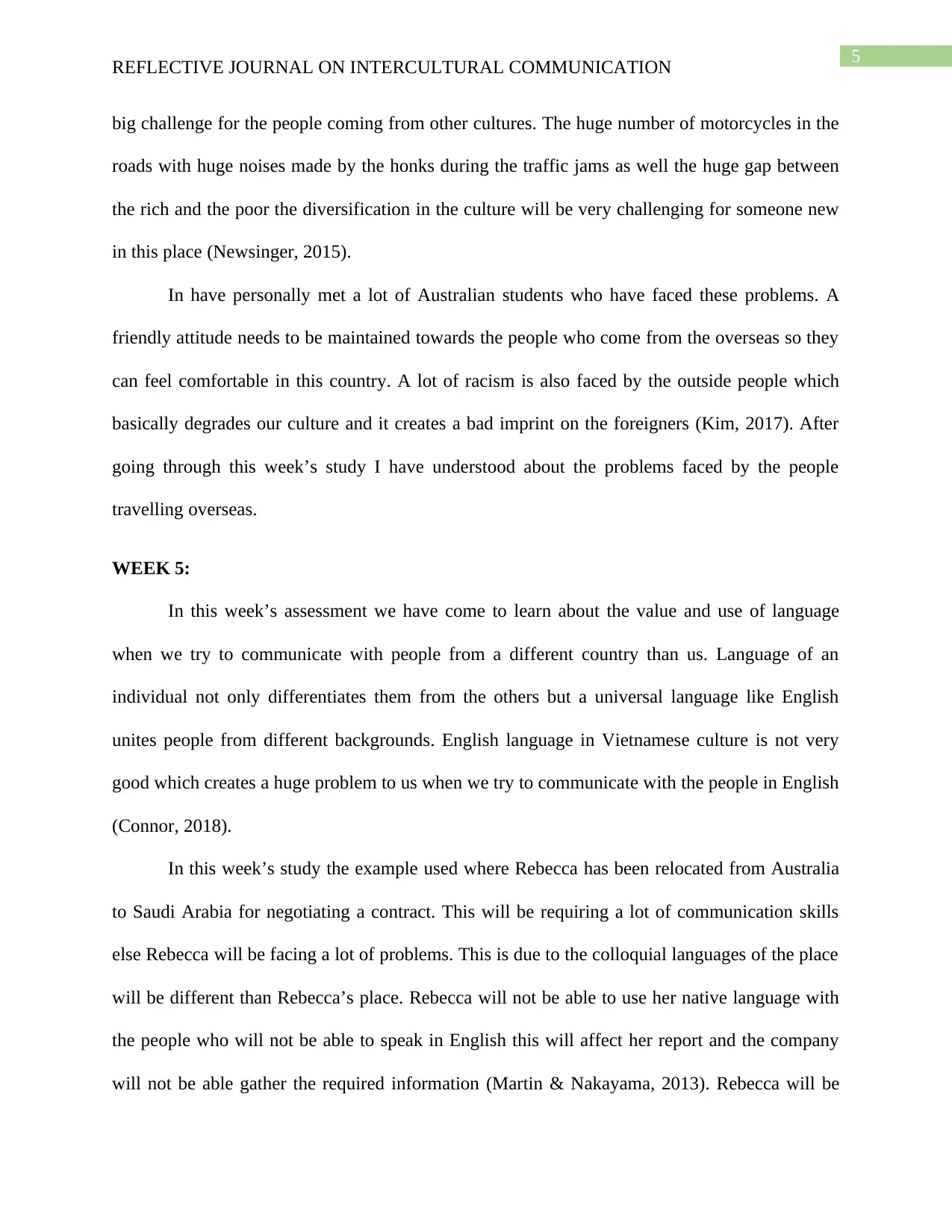
5
REFLECTIVE JOURNAL ON INTERCULTURAL COMMUNICATION
big challenge for the people coming from other cultures. The huge number of motorcycles in the
roads with huge noises made by the honks during the traffic jams as well the huge gap between
the rich and the poor the diversification in the culture will be very challenging for someone new
in this place (Newsinger, 2015).
In have personally met a lot of Australian students who have faced these problems. A
friendly attitude needs to be maintained towards the people who come from the overseas so they
can feel comfortable in this country. A lot of racism is also faced by the outside people which
basically degrades our culture and it creates a bad imprint on the foreigners (Kim, 2017). After
going through this week’s study I have understood about the problems faced by the people
travelling overseas.
WEEK 5:
In this week’s assessment we have come to learn about the value and use of language
when we try to communicate with people from a different country than us. Language of an
individual not only differentiates them from the others but a universal language like English
unites people from different backgrounds. English language in Vietnamese culture is not very
good which creates a huge problem to us when we try to communicate with the people in English
(Connor, 2018).
In this week’s study the example used where Rebecca has been relocated from Australia
to Saudi Arabia for negotiating a contract. This will be requiring a lot of communication skills
else Rebecca will be facing a lot of problems. This is due to the colloquial languages of the place
will be different than Rebecca’s place. Rebecca will not be able to use her native language with
the people who will not be able to speak in English this will affect her report and the company
will not be able gather the required information (Martin & Nakayama, 2013). Rebecca will be
REFLECTIVE JOURNAL ON INTERCULTURAL COMMUNICATION
big challenge for the people coming from other cultures. The huge number of motorcycles in the
roads with huge noises made by the honks during the traffic jams as well the huge gap between
the rich and the poor the diversification in the culture will be very challenging for someone new
in this place (Newsinger, 2015).
In have personally met a lot of Australian students who have faced these problems. A
friendly attitude needs to be maintained towards the people who come from the overseas so they
can feel comfortable in this country. A lot of racism is also faced by the outside people which
basically degrades our culture and it creates a bad imprint on the foreigners (Kim, 2017). After
going through this week’s study I have understood about the problems faced by the people
travelling overseas.
WEEK 5:
In this week’s assessment we have come to learn about the value and use of language
when we try to communicate with people from a different country than us. Language of an
individual not only differentiates them from the others but a universal language like English
unites people from different backgrounds. English language in Vietnamese culture is not very
good which creates a huge problem to us when we try to communicate with the people in English
(Connor, 2018).
In this week’s study the example used where Rebecca has been relocated from Australia
to Saudi Arabia for negotiating a contract. This will be requiring a lot of communication skills
else Rebecca will be facing a lot of problems. This is due to the colloquial languages of the place
will be different than Rebecca’s place. Rebecca will not be able to use her native language with
the people who will not be able to speak in English this will affect her report and the company
will not be able gather the required information (Martin & Nakayama, 2013). Rebecca will be
⊘ This is a preview!⊘
Do you want full access?
Subscribe today to unlock all pages.

Trusted by 1+ million students worldwide
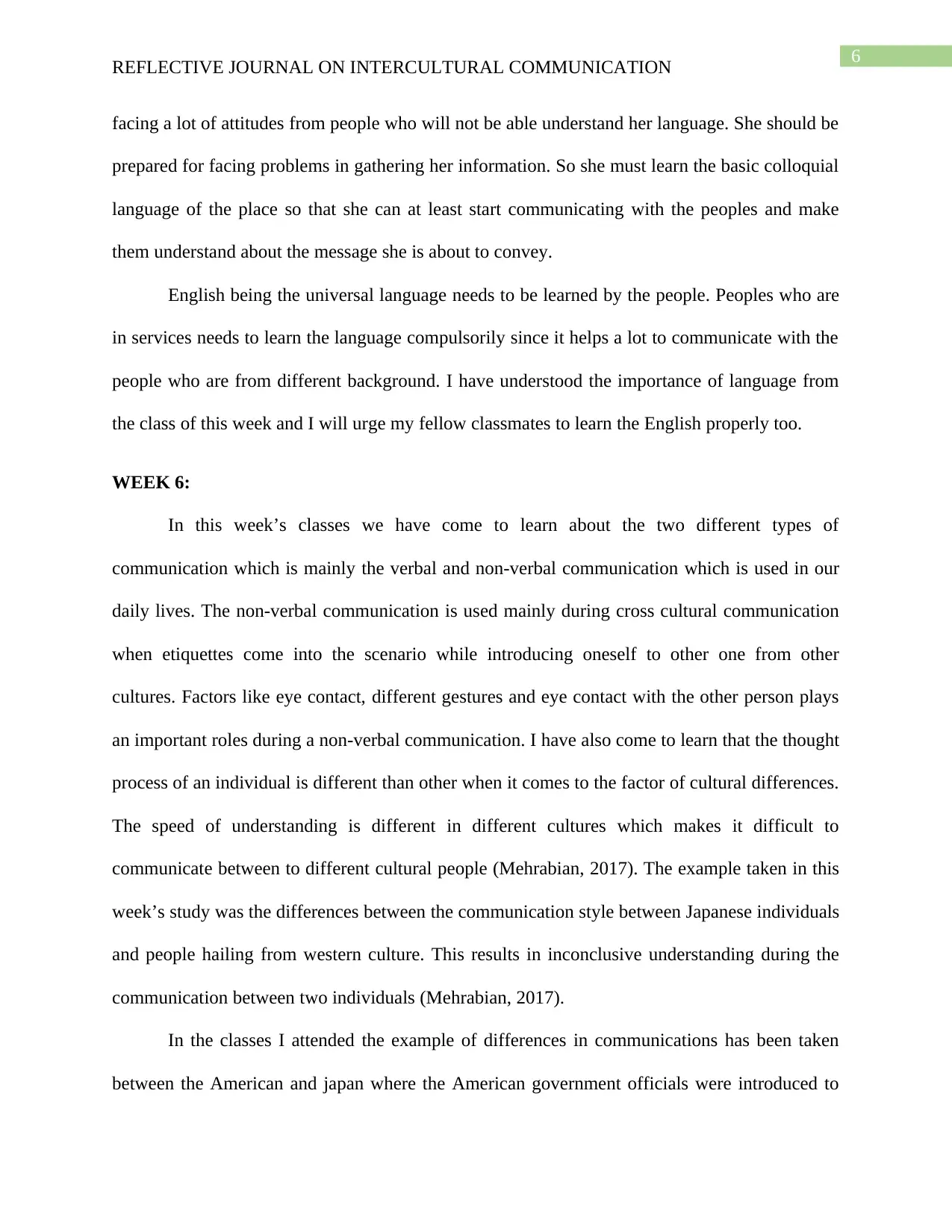
6
REFLECTIVE JOURNAL ON INTERCULTURAL COMMUNICATION
facing a lot of attitudes from people who will not be able understand her language. She should be
prepared for facing problems in gathering her information. So she must learn the basic colloquial
language of the place so that she can at least start communicating with the peoples and make
them understand about the message she is about to convey.
English being the universal language needs to be learned by the people. Peoples who are
in services needs to learn the language compulsorily since it helps a lot to communicate with the
people who are from different background. I have understood the importance of language from
the class of this week and I will urge my fellow classmates to learn the English properly too.
WEEK 6:
In this week’s classes we have come to learn about the two different types of
communication which is mainly the verbal and non-verbal communication which is used in our
daily lives. The non-verbal communication is used mainly during cross cultural communication
when etiquettes come into the scenario while introducing oneself to other one from other
cultures. Factors like eye contact, different gestures and eye contact with the other person plays
an important roles during a non-verbal communication. I have also come to learn that the thought
process of an individual is different than other when it comes to the factor of cultural differences.
The speed of understanding is different in different cultures which makes it difficult to
communicate between to different cultural people (Mehrabian, 2017). The example taken in this
week’s study was the differences between the communication style between Japanese individuals
and people hailing from western culture. This results in inconclusive understanding during the
communication between two individuals (Mehrabian, 2017).
In the classes I attended the example of differences in communications has been taken
between the American and japan where the American government officials were introduced to
REFLECTIVE JOURNAL ON INTERCULTURAL COMMUNICATION
facing a lot of attitudes from people who will not be able understand her language. She should be
prepared for facing problems in gathering her information. So she must learn the basic colloquial
language of the place so that she can at least start communicating with the peoples and make
them understand about the message she is about to convey.
English being the universal language needs to be learned by the people. Peoples who are
in services needs to learn the language compulsorily since it helps a lot to communicate with the
people who are from different background. I have understood the importance of language from
the class of this week and I will urge my fellow classmates to learn the English properly too.
WEEK 6:
In this week’s classes we have come to learn about the two different types of
communication which is mainly the verbal and non-verbal communication which is used in our
daily lives. The non-verbal communication is used mainly during cross cultural communication
when etiquettes come into the scenario while introducing oneself to other one from other
cultures. Factors like eye contact, different gestures and eye contact with the other person plays
an important roles during a non-verbal communication. I have also come to learn that the thought
process of an individual is different than other when it comes to the factor of cultural differences.
The speed of understanding is different in different cultures which makes it difficult to
communicate between to different cultural people (Mehrabian, 2017). The example taken in this
week’s study was the differences between the communication style between Japanese individuals
and people hailing from western culture. This results in inconclusive understanding during the
communication between two individuals (Mehrabian, 2017).
In the classes I attended the example of differences in communications has been taken
between the American and japan where the American government officials were introduced to
Paraphrase This Document
Need a fresh take? Get an instant paraphrase of this document with our AI Paraphraser
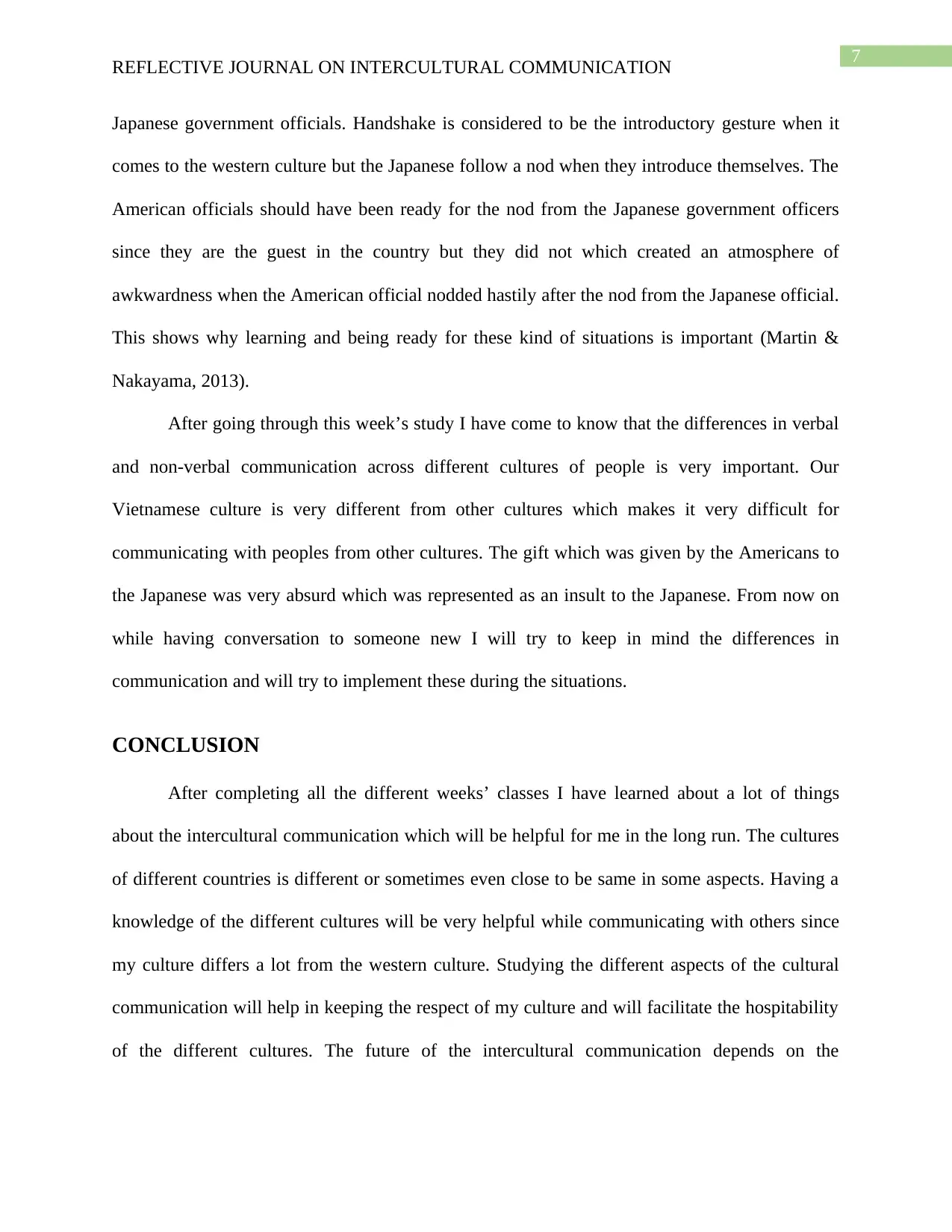
7
REFLECTIVE JOURNAL ON INTERCULTURAL COMMUNICATION
Japanese government officials. Handshake is considered to be the introductory gesture when it
comes to the western culture but the Japanese follow a nod when they introduce themselves. The
American officials should have been ready for the nod from the Japanese government officers
since they are the guest in the country but they did not which created an atmosphere of
awkwardness when the American official nodded hastily after the nod from the Japanese official.
This shows why learning and being ready for these kind of situations is important (Martin &
Nakayama, 2013).
After going through this week’s study I have come to know that the differences in verbal
and non-verbal communication across different cultures of people is very important. Our
Vietnamese culture is very different from other cultures which makes it very difficult for
communicating with peoples from other cultures. The gift which was given by the Americans to
the Japanese was very absurd which was represented as an insult to the Japanese. From now on
while having conversation to someone new I will try to keep in mind the differences in
communication and will try to implement these during the situations.
CONCLUSION
After completing all the different weeks’ classes I have learned about a lot of things
about the intercultural communication which will be helpful for me in the long run. The cultures
of different countries is different or sometimes even close to be same in some aspects. Having a
knowledge of the different cultures will be very helpful while communicating with others since
my culture differs a lot from the western culture. Studying the different aspects of the cultural
communication will help in keeping the respect of my culture and will facilitate the hospitability
of the different cultures. The future of the intercultural communication depends on the
REFLECTIVE JOURNAL ON INTERCULTURAL COMMUNICATION
Japanese government officials. Handshake is considered to be the introductory gesture when it
comes to the western culture but the Japanese follow a nod when they introduce themselves. The
American officials should have been ready for the nod from the Japanese government officers
since they are the guest in the country but they did not which created an atmosphere of
awkwardness when the American official nodded hastily after the nod from the Japanese official.
This shows why learning and being ready for these kind of situations is important (Martin &
Nakayama, 2013).
After going through this week’s study I have come to know that the differences in verbal
and non-verbal communication across different cultures of people is very important. Our
Vietnamese culture is very different from other cultures which makes it very difficult for
communicating with peoples from other cultures. The gift which was given by the Americans to
the Japanese was very absurd which was represented as an insult to the Japanese. From now on
while having conversation to someone new I will try to keep in mind the differences in
communication and will try to implement these during the situations.
CONCLUSION
After completing all the different weeks’ classes I have learned about a lot of things
about the intercultural communication which will be helpful for me in the long run. The cultures
of different countries is different or sometimes even close to be same in some aspects. Having a
knowledge of the different cultures will be very helpful while communicating with others since
my culture differs a lot from the western culture. Studying the different aspects of the cultural
communication will help in keeping the respect of my culture and will facilitate the hospitability
of the different cultures. The future of the intercultural communication depends on the

8
REFLECTIVE JOURNAL ON INTERCULTURAL COMMUNICATION
implementation of tools in the various sectors which will be improving business across different
platforms as well as will be facilitating the communication across worlds.
REFLECTIVE JOURNAL ON INTERCULTURAL COMMUNICATION
implementation of tools in the various sectors which will be improving business across different
platforms as well as will be facilitating the communication across worlds.
⊘ This is a preview!⊘
Do you want full access?
Subscribe today to unlock all pages.

Trusted by 1+ million students worldwide
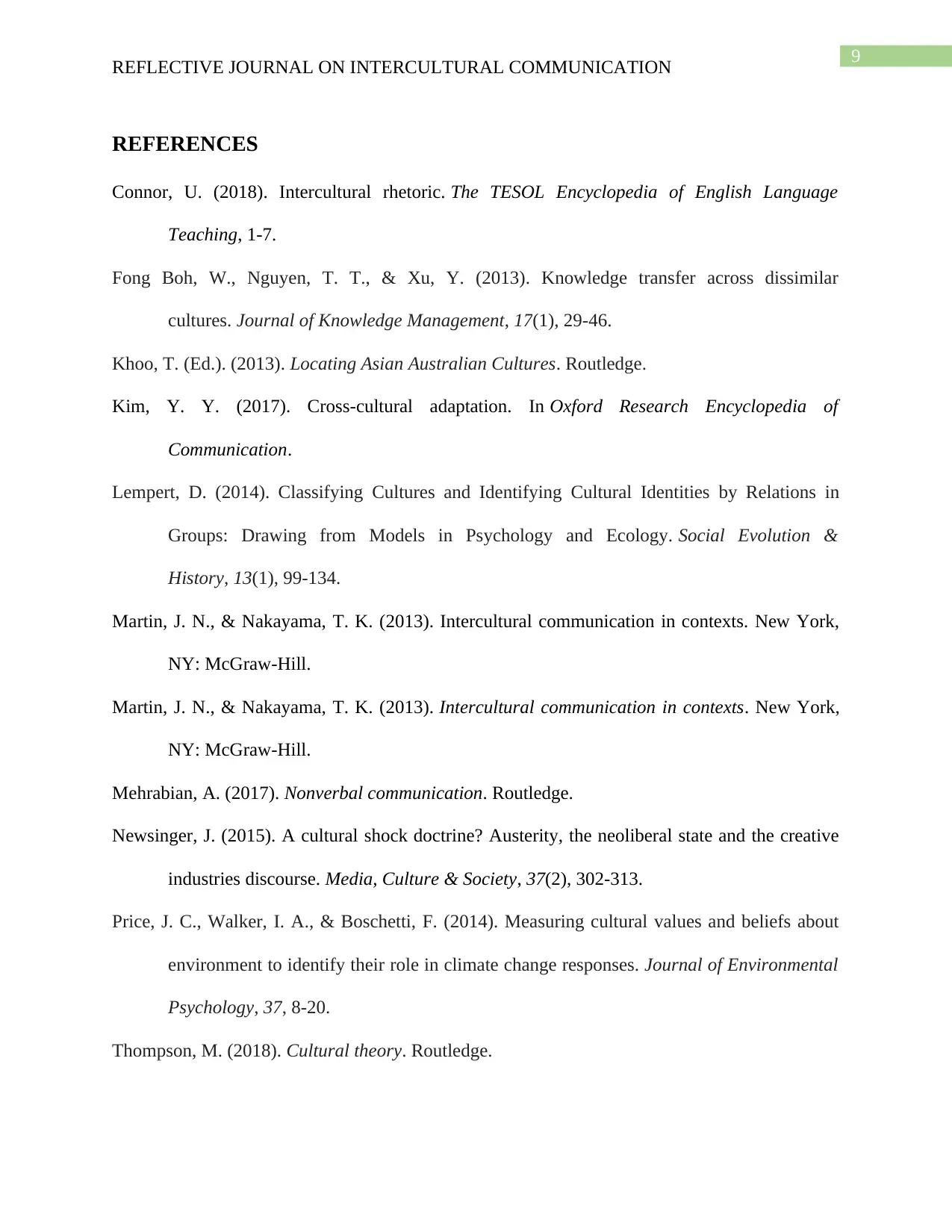
9
REFLECTIVE JOURNAL ON INTERCULTURAL COMMUNICATION
REFERENCES
Connor, U. (2018). Intercultural rhetoric. The TESOL Encyclopedia of English Language
Teaching, 1-7.
Fong Boh, W., Nguyen, T. T., & Xu, Y. (2013). Knowledge transfer across dissimilar
cultures. Journal of Knowledge Management, 17(1), 29-46.
Khoo, T. (Ed.). (2013). Locating Asian Australian Cultures. Routledge.
Kim, Y. Y. (2017). Cross-cultural adaptation. In Oxford Research Encyclopedia of
Communication.
Lempert, D. (2014). Classifying Cultures and Identifying Cultural Identities by Relations in
Groups: Drawing from Models in Psychology and Ecology. Social Evolution &
History, 13(1), 99-134.
Martin, J. N., & Nakayama, T. K. (2013). Intercultural communication in contexts. New York,
NY: McGraw-Hill.
Martin, J. N., & Nakayama, T. K. (2013). Intercultural communication in contexts. New York,
NY: McGraw-Hill.
Mehrabian, A. (2017). Nonverbal communication. Routledge.
Newsinger, J. (2015). A cultural shock doctrine? Austerity, the neoliberal state and the creative
industries discourse. Media, Culture & Society, 37(2), 302-313.
Price, J. C., Walker, I. A., & Boschetti, F. (2014). Measuring cultural values and beliefs about
environment to identify their role in climate change responses. Journal of Environmental
Psychology, 37, 8-20.
Thompson, M. (2018). Cultural theory. Routledge.
REFLECTIVE JOURNAL ON INTERCULTURAL COMMUNICATION
REFERENCES
Connor, U. (2018). Intercultural rhetoric. The TESOL Encyclopedia of English Language
Teaching, 1-7.
Fong Boh, W., Nguyen, T. T., & Xu, Y. (2013). Knowledge transfer across dissimilar
cultures. Journal of Knowledge Management, 17(1), 29-46.
Khoo, T. (Ed.). (2013). Locating Asian Australian Cultures. Routledge.
Kim, Y. Y. (2017). Cross-cultural adaptation. In Oxford Research Encyclopedia of
Communication.
Lempert, D. (2014). Classifying Cultures and Identifying Cultural Identities by Relations in
Groups: Drawing from Models in Psychology and Ecology. Social Evolution &
History, 13(1), 99-134.
Martin, J. N., & Nakayama, T. K. (2013). Intercultural communication in contexts. New York,
NY: McGraw-Hill.
Martin, J. N., & Nakayama, T. K. (2013). Intercultural communication in contexts. New York,
NY: McGraw-Hill.
Mehrabian, A. (2017). Nonverbal communication. Routledge.
Newsinger, J. (2015). A cultural shock doctrine? Austerity, the neoliberal state and the creative
industries discourse. Media, Culture & Society, 37(2), 302-313.
Price, J. C., Walker, I. A., & Boschetti, F. (2014). Measuring cultural values and beliefs about
environment to identify their role in climate change responses. Journal of Environmental
Psychology, 37, 8-20.
Thompson, M. (2018). Cultural theory. Routledge.
Paraphrase This Document
Need a fresh take? Get an instant paraphrase of this document with our AI Paraphraser

10
REFLECTIVE JOURNAL ON INTERCULTURAL COMMUNICATION
Valle, R., & Gait, H. C. (2014). Caregiving across cultures: Working with dementing illness and
ethnically diverse populations. Routledge.
REFLECTIVE JOURNAL ON INTERCULTURAL COMMUNICATION
Valle, R., & Gait, H. C. (2014). Caregiving across cultures: Working with dementing illness and
ethnically diverse populations. Routledge.
1 out of 11
Related Documents
Your All-in-One AI-Powered Toolkit for Academic Success.
+13062052269
info@desklib.com
Available 24*7 on WhatsApp / Email
![[object Object]](/_next/static/media/star-bottom.7253800d.svg)
Unlock your academic potential
Copyright © 2020–2025 A2Z Services. All Rights Reserved. Developed and managed by ZUCOL.




